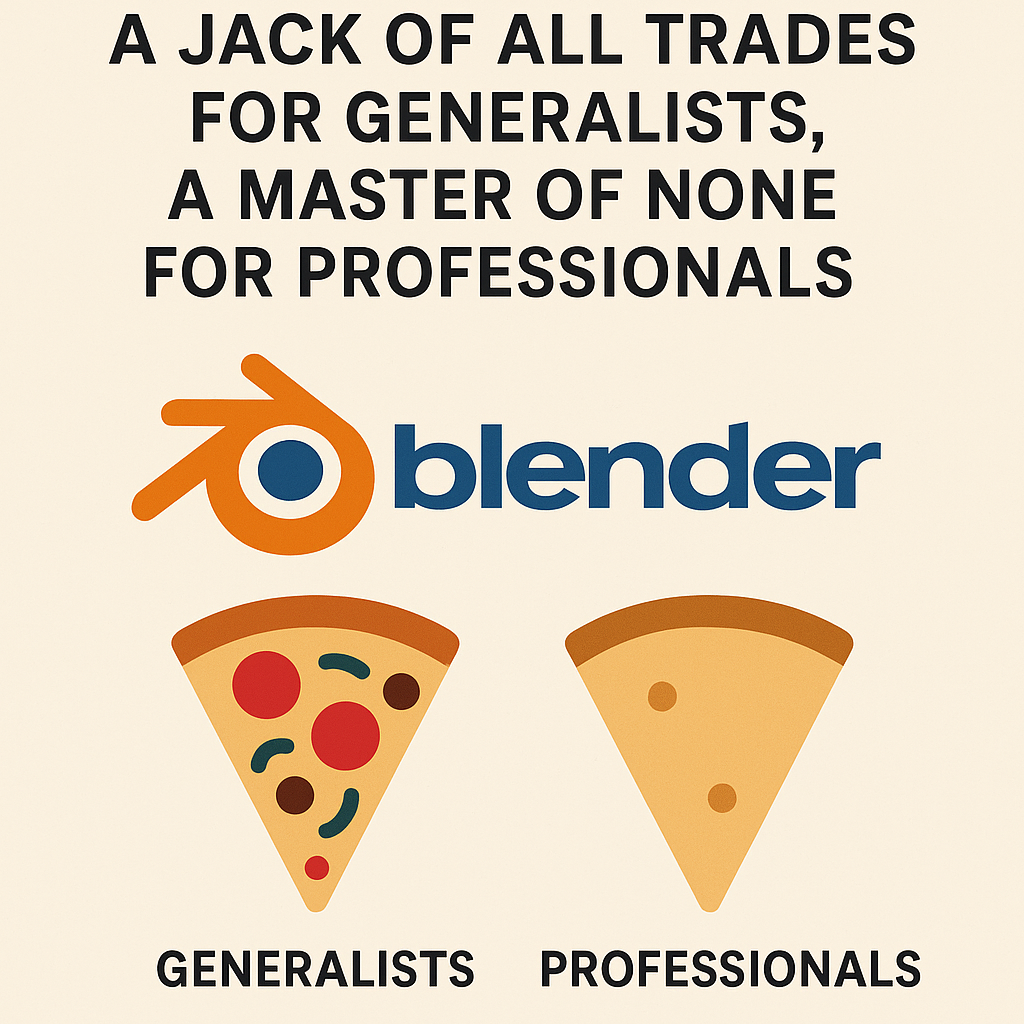
Author’s Note
I have lived and taught 3D software for over twelve years. I spent an entire year wrestling with Blender—not out of hype or community pressure, but to understand it myself. The conclusion is clear: Blender is a software that tries to do everything—modeling, animation, compositing, even video editing. It is like a mixed pizza: you taste a bit of everything, but you never get the depth of any one flavor. I am not against Blender; I am against the claims that present it as a “replacement for everything.” Respecting every tool is essential, but so is drawing a line between a learning tool and a professional tool. Blender is great for beginners and small projects, but in specialized and large-scale work, its hidden costs reveal themselves—from paid add-ons to frustrating instability. This article is not an attack on Blender; it is a defense of specialization. Blender has value, but not for everything, and not for everyone.
Blender: The Mixed Pizza of the 3D World
Blender claims to offer the entire 3D pipeline under one roof: modeling, rigging, animation, rendering, compositing, even video editing. At first glance, this all-in-one promise seems appealing. But the result is breadth without depth. A tool that tries to be everything, ends up excelling at nothing.
Comparison with Specialized Software
In every field of 3D, specialized tools dominate.
- In architecture, we rely on Revit for building design and 3ds Max for complex, non-Euclidean forms.
- For character creation, ZBrush and 3D Coat remain unmatched.
- For texturing, Substance Painter is the industry standard.
- For UV unwrapping, RizomUV provides unmatched precision.
- For rigging and animation, Maya has been the global standard for decades.
- In compositing and VFX, tools like Nuke and After Effects lead the way.
- For simulations such as destruction, fluids, and gases, Houdini is the clear choice.
The pattern is obvious: the moment you try to go deeper into any specialized stage, Blender abandons you.
The Illusion of Being Free
Blender’s biggest marketing point is that it is free and open-source. But this “free” label only works if you stay at a beginner’s or hobbyist’s level. Once you step into specialized work, you quickly discover that many of the features you need exist only as paid add-ons.
In short: Blender is free at the surface, but hidden costs appear as soon as you demand professional depth. Free does not equal professional. Blender is a good place to start—but rarely the place to finish.
Lightweight Charm; Heavyweight Failure
One of Blender’s appealing traits is that it feels lightweight. It loads fast, runs smoothly, and seems efficient for small projects. Beginners often fall in love with this simplicity.
But once the project grows—more assets, complex rigs, heavy textures—the mask falls off. Blender slows down, bugs appear, crashes multiply, and the software struggles to manage the workload.
My personal experience after a year confirmed this: projects that ran smoothly at first collapsed as soon as they became complex. Where Maya, ZBrush, or Houdini remain stable, Blender falls apart.
Lightweight performance is an advantage at the beginning. But the inability to scale is a fundamental weakness.
Who Is Blender Really For?
Blender is not for everyone, but it does have a clear audience:
- Students and beginners who need a free entry point into 3D.
- Generalists who prefer to touch many fields rather than specialize deeply.
- Low-budget freelancers working on small, independent projects.
- Prototyping and concept work, where speed matters more than final quality.
Blender is ideal as a learning tool or for small projects. It is not designed for industrial, studio-level pipelines.
Where Blender Actually Shines
Despite its limits, Blender does shine in certain areas:
- Free and accessible for anyone starting out.
- Active community with countless tutorials and forums.
- Fast and efficient for small projects.
- Flexibility for experimentation, letting you test ideas without relying on multiple tools.
Blender is bright at the starting point, but this brightness should not be mistaken for professional readiness.
The Professional Pipeline and Industry Reality
In the 3D industry, no studio expects one software to do everything. The strength of the pipeline lies in specialization. Here is a simplified example of a professional workflow:
- Modeling: Revit / 3ds Max / ZBrush
- Retopology: 3ds Max or Maya
- UV Unwrapping: RizomUV
- Texturing & LookDev: Substance Painter
- Rigging & Animation: Maya
- VFX & Simulation: Houdini
- Compositing: Nuke / After Effects
- Rendering: V-Ray, Arnold, Redshift, or game engines like Unreal
Every stage has its own specialized tool. Blender can play a small role in this chain, but it is not a replacement for dedicated, battle-tested software.
Conclusion: A Jack of All Trades for Generalists, a Master of None for Professionals
Blender is an excellent tool for learning, experimenting, and small-scale work. It is free, accessible, and flexible for those who are just starting out. But when it comes to professional, specialized, or large-scale projects, its weaknesses become unavoidable.
The verdict is simple: Blender is a jack of all trades for generalists, but a master of none for professionals.
Author: Pouria Mojdeh – Architect, Independent Game Developer, University Lecturer
